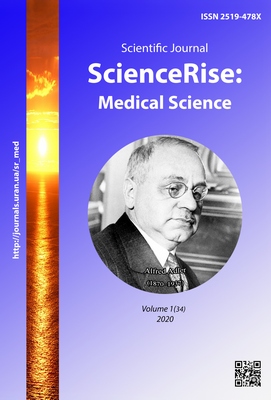L-arginin in the complex treatment of the patients with arterial hypertension and diabetes mellitus in perimenopause
DOI:
https://doi.org/10.15587/2519-4798.2020.193270Keywords:
arterial hypertension, diabetes mellitus, endothelial dysfunction, myocardium, perimenopause, nitrogen oxide donator, L-argininAbstract
The aim of research was comparing the influence of basic therapy (lisinopril or amlodipine) as a monotherapy and its combination with nitrogen oxide donator – L-arginin in the patients with arterial hypertension in perimenopause with comorbid diabetes mellitus and without it.
Material and methods of our investigation: we examined 104 patients using biochemical (endothelin’s level determination) and instrumental (Doppler echocardiography) diagnostic methods.
Result. Results have shown that on the background of treatment, myocardial function improves and diastolic dysfunction is regressing in all patient’s groups. The most pronounced changes we can see in the subgroup of the patients, who additionally used L-arginine. The endothelin’s-1 level changes are also the most pronounced in patients, who used L-arginine. The feasibility of L-arginine adding is justified as it has positive influence on the endothelial dysfunction, which manifested itself in a decreased endothelin’s-1 level.
Conclusions. We have shown that on the background of treatment the myocardial contractility become better. The most pronounced changes we can see in the subgroup of the patients, who used L-arginine (diastolic dysfunction regressed from the second to the first type in 21 patients (47.7 %), which prove a positive influence on the left ventricular filling pressures)
References
- Sirenko, Yu M. (2012). Tsilovyi riven arterialnoho tysku u khvorykh na tsukrovyi diabet 2-ho typu: otsinka naukovykh dokaziv. Ukrainskyi kardiolohichnyi zhurnal, 6, 27–32.
- Wang, D., Wang, C., Wu, X., Zheng, W., Sandberg, K., Ji, H. et. al. (2014). Endothelial Dysfunction and Enhanced Contractility in Microvessels From Ovariectomized Rats: roles of oxidative stress and perivascular adipose. Hypertension, 63 (5), 1063–1069. doi: http://doi.org/10.1161/hypertensionaha.113.02284
- Avendaño, M. S., Lucas, E., Jurado-Pueyo, M., Martínez-Revelles, S., Vila-Bedmar, R., Mayor, F. et. al. (2014). Increased Nitric Oxide Bioavailability in Adult GRK2 Hemizygous Mice Protects Against Angiotensin II–Induced Hypertension. Hypertension, 63 (2), 369–375. doi: http://doi.org/10.1161/hypertensionaha.113.01991
- Carter, J. R., Fu, Q., Minson, C. T., Joyner, M. J. (2013). Ovarian Cycle and Sympathoexcitation in Premenopausal Women. Hypertension, 61 (2), 395–399. doi: http://doi.org/10.1161/hypertensionaha.112.202598
- Voloshynska, K. O., Ilashchuk, T. O. (2017). Clinical and pathogenetic peculiarities of type 2 diabetes in menopausal female patients. BDMU. Chernivci, 133.
- Bazylevych, A. Ya. (2014). Ohliad novyn Konhresu Yevropeiskoho tovarystva kardiolohiv. Liky Ukrainy, 7-8, 34–41.
- Böhm, M., Reil, J.-C., Deedwania, P., Kim, J. B., Borer, J. S. (2015). Resting Heart Rate: Risk Indicator and Emerging Risk Factor in Cardiovascular Disease. The American Journal of Medicine, 128 (3), 219–228. doi: http://doi.org/10.1016/j.amjmed.2014.09.016
- Spescha, R. D., Glanzmann, M., Simic, B., Witassek, F., Keller, S., Akhmedov, A. et. al. (2014). Adaptor Protein p66Shc Mediates Hypertension-Associated, Cyclic Stretch–Dependent, Endothelial Damage. Hypertension, 64 (2), 347–353. doi: http://doi.org/10.1161/hypertensionaha.113.02129
- ESH/ESC Guidelines for the management of arterial hypertension. (2013). European Heart Journal, 34 (28), 2159–2219. doi: http://doi.org/10.1093/eurheartj/eht151
- Caetano, J., Delgado Alves, J. (2015). Heart rate and cardiovascular protection. European Journal of Internal Medicine, 26 (4), 217–222. doi: http://doi.org/10.1016/j.ejim.2015.02.009
- Nascimento, M. A., Higa, E. M. S., de Mello, M. T., Tufik, S., Oyama, L. M., Santos, R. V. et. al. (2014). Effects of short-term l-arginine supplementation on lipid profile and inflammatory proteins after acute resistance exercise in overweight men. e-SPEN Journal, 9 (3), e141–e145. doi: http://doi.org/10.1016/j.clnme.2014.02.002
Downloads
Published
How to Cite
Issue
Section
License
Copyright (c) 2020 Kateryna Voloshynska, Sergey Kovalchuk, Maria Kovalchuk, Olga Peresunko

This work is licensed under a Creative Commons Attribution 4.0 International License.
Our journal abides by the Creative Commons CC BY copyright rights and permissions for open access journals.
Authors, who are published in this journal, agree to the following conditions:
1. The authors reserve the right to authorship of the work and pass the first publication right of this work to the journal under the terms of a Creative Commons CC BY, which allows others to freely distribute the published research with the obligatory reference to the authors of the original work and the first publication of the work in this journal.
2. The authors have the right to conclude separate supplement agreements that relate to non-exclusive work distribution in the form in which it has been published by the journal (for example, to upload the work to the online storage of the journal or publish it as part of a monograph), provided that the reference to the first publication of the work in this journal is included.









